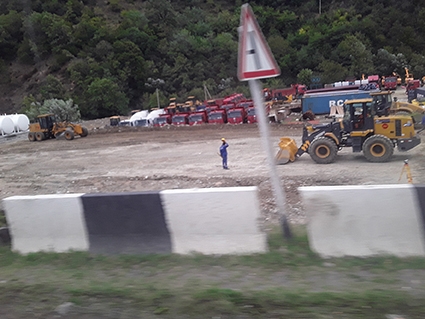Doubling: Rikoti Pass, Georgia
BLOG
I had some swift business in Tbilisi, so, time to shut up shop and guest house for just a couple of days. Having washed up from serving breakfast to 10 guests, I handed over barn duties to kind neighbors and fled the scene with just a single small day-backpack.
After about 10 cars ignored my outstretched hitchhiking hand, one stopped: my first time ever taking a taxi from our village down to Zugdidi, the hour being just a bit too late for the morning minivan runs. Fortunately, the car was shared, so the price per passenger was only 20 GEL.
Three hours later… I played in my head this little speech: “Use this money to get your [broken] speedometer fixed, so you can see how fast you’re NOT going.” But instead of delivering it, I just paid up and left, memorizing the car’s make, model and license plate so as never to take it again. Next stop, after a quick lunch, Zugdidi railway station, where I was the last passenger to board the minibus and off we set towards the Big City.
However, this leg turned out to be no faster. Probably due to a combination of factors. One was the slightly later hour when we hit the bottleneck part, the Rikoti Pass after Zestaponi, now with more big trucks on it slowing everything down in the many places where the twists and turns prevent overtaking.
The other was that this section, 60 km or so long, is now finally being doubled in width, part of the decade or so long program to massively upgrade the main road through the whole of Georgia from Azerbaijan to the Black Sea coast cities. West from Tbilisi, we’re completed almost to the Pass now, nearing Khashuri and Surami at its east end. But for years I have been wondering: in these narrow places, just how are the road engineers going to proceed? Surely they can’t find or make the necessary space for the job! So many new bridges and tunnels to build; will they simply bypass this whole road and take the highway elsewhere? We were forced to use bad-grade alternate routes across the country for a while after the 2008 war anyway, as Russia had bombed the main bridge near Gori.
Well, it looks like they’re going through. In many spots there are temporary buildings erected to house the hundreds of workers living here; hundreds of heavy machines are parked or busy; cement factories have been built; forest sections are being cleared, ramps built, much earth moved. It’s a massive project which could take years; it will also have to wait when snows come, as they do to this area. Most of the highway will, just like the bit immediately west of Tbilisi’s edge, be on two different levels, one for each direction. It is a badly needed increase in road space for this otherwise dreadful trucking and slowdown section, which was crawling at walking pace for quite a bit if its length when I took it.
I only hope the homeowners who are forced to sell and move are being properly compensated. As for the churches along the road, well, especially the old ones will simply stand where they are, forcing detours as they can’t be moved and are too important to be lost. And the local clay-works, originally just at Shrosha but now much more widespread, which are a mainstay of the area? I also hope that these will survive to make more qvevrebi (amphorae for wine) and tonebi (cylindrical bread ovens).
Of course, the question must be asked, why now? Well, either simply because the time has come for this stretch of road to be tackled; or because there are Elections looming and we must be seen to be being busy!
Tony Hanmer has lived in Georgia since 1999, in Svaneti since 2007, and been a weekly writer for GT since early 2011. He runs the “Svaneti Renaissance” Facebook group, now with nearly 2000 members, at www.facebook.com/groups/SvanetiRenaissance/
He and his wife also run their own guest house in Etseri:
www.facebook.com/hanmer.house.svaneti
By Tony Hanmer












